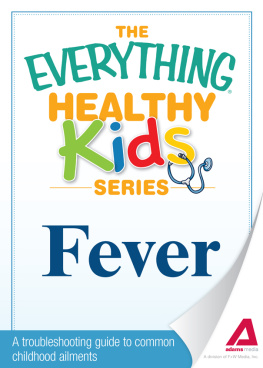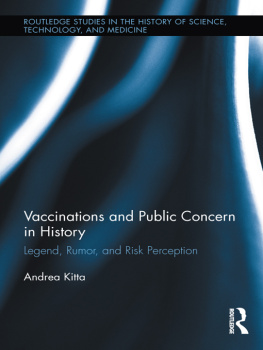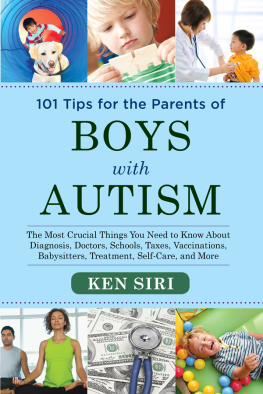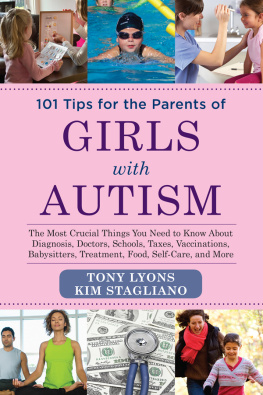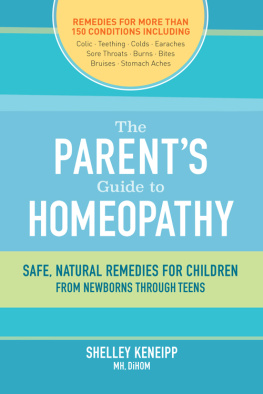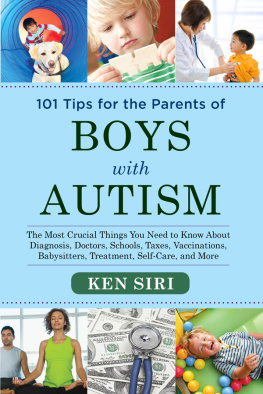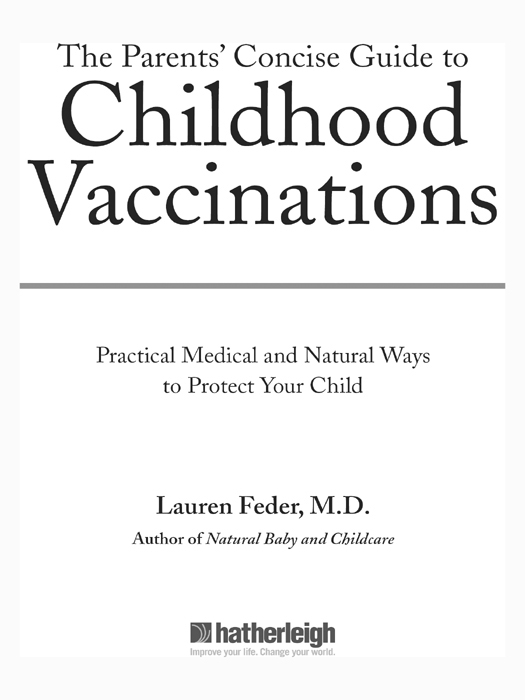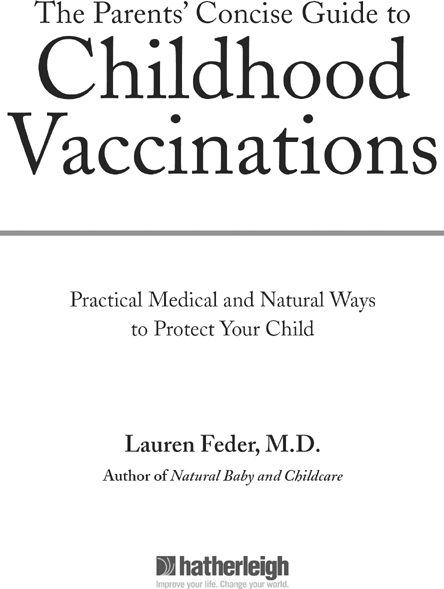M any thanks to my editor, Andrea Au; the production team, including Deborah Miller, Allison Furrer, and Mary Jane DeFroscia; and the publicity/marketing team, including Kevin Moran and Mariel Dumas, for their dedication to the project. In addition, my gratitude extends to my agent, Jessica Faust.
To parents who I have worked with and share the common aim of raising happy and healthy children. To my family, friends, and my loving sons tienne and Quentin, who inspired me to take this journey and supported me along the way.
And my deep appreciation to the philosopher Mervyn Brady and the students of the Academy of European Arts and Culture, whose infinite wisdom guides me along my journey.
Lauren Feder, M.D.
Los Angeles
DEDICATION
To my mother, Ellie Davis,
who showed me the love of motherhood,
and my father, Dr. Robert J. Feder,
the love of medicine.
CONTENTS
CHAPTER 1
CHAPTER 2
CHAPTER 3
CHAPTER 4
CHAPTER 5
CHAPTER 6
CHAPTER 7
INTRODUCTION
The Vaccination Controversy
W hen I was growing up, going to the doctor for shots was a time honored tradition that we all acceptedlike it or not! Even during my training as a resident at the hospital, I dutifully went for yearly physicals, which included an updating of the basic adult immunizations. Like my parents, I never questioned vaccinations and did not consider them anything but a normal part of routine prevention of illnesses. It wasnt until I was successfully treated for a thyroid condition with holistic medicine that I became interested in the complementary medical approach of using the bodys natural defenses against disease as much as possible. In this view, vaccinations can interfere with the bodys natural immunity and may themselves cause disease.
Vaccinations, which for decades had been hailed as one of the major achievements in public health, are no longer immune to controversy. In our grandparents days, nearly all children had measles, mumps, and rubella. Its not uncommon to hear stories about chickenpox parties in our parents days that flourished at the first sign of the rash when all the mothers would rush their children over to the infected childs house. Since the introduction of vaccines in the twentieth century, these common childhood diseases are no longer common. This would seem to be good news. But in recent years, professional journals and newspapers have reported with increasing frequency on vaccine injuries, mercury toxicity, and possible links between vaccinations and chronic diseases such as autism.
One of the first major health decisions facing new parents is whether or not to vaccinate. Many parents do not even realize there is a choice, as there has been the assumption that vaccinations are compulsory rather than voluntary for entry into school. Vaccinations are recommended by our healthcare system for every child. However, like any medication, vaccinations carry the risk of adverse effects and are not always 100 percent safe. Sometimes a child can experience a reaction after a shotdiscomfort, allergic reactions, and even reports of death have occurred. Stories in the media about the link between autism and the measles, mumps, and rubella (MMR) shot are prevalent. As a result, a growing number of parents have begun to question the safety and effectiveness of vaccines. Nowadays, with the abundance of information available, parents are more informed about the health benefits and risks of vaccinations, pose more questions to their doctors, and are interested in taking some responsibility for their childrens health and wellbeing. Some of my patients fully vaccinate to schedule, some not at all, and others vaccinate selectively.
The Current State of Our Childrens Health
Medical advancements in the 1900s were impressive in their achievements: We are treating diseases with more sophisticated techniques, targeting illness with complex drugs and extensive therapeutic regimes. We understand the mechanics of the body better than at any time in history. But even as we are told we are healthier and living longer, more children every year are on daily medications for chronic conditions. In recent years, I have witnessed a dramatic increase in these sorts of conditionschildren who suffer from repeated ear infections, severe asthma, allergies, or eczema, or even behavioral problems like Attention Deficit Hyperactivity Disorder (ADHD).
The explanations for the increase in chronic childhood illnesses are complex and often contradictory; the effects on children and families, however, are profound and evident. As a result, more parents every year confront the limits of conventional medicine in treating and addressing the causes of chronic illnesses like these.
Unfortunately, healthcare in the United States has a long way to go before it is satisfactory. According to an article in the Journal of the American Medical Association (Barbara Starfield, M.D., Is U.S. Health Really the Best in the World? JAMA. 2000; 284: 483485) the United States ranked 12th out of a group of 13 countries when measured on health indicators such as low birth weight, infant mortality, and life expectancy. Our children, who represent the future generation, may be more at risk than we were. Many of our children, for instance, are ingesting more than safe amounts of fluoride from local water supplies, which damages tooth enamel, ligaments, muscles, and skin, and is associated with lower IQ levels, arthritis, and cancer. Mercury used in amalgam dental fillings is known to be toxic and may lead to damage to the brain, kidney, and immune system. Antibiotic overuse has caused antibiotic resistance, yeast overgrowth, and weakening of the immune system.
Nowadays, according to the American Obesity Association, 15 percent of children in the United States are obese, an increase of over 50 percent in children ages 6 to 11 since the 1960s. Most overweight adolescents grow up to become obese adults. This alarming rise in obesity has been blamed upon a number of societal causes, including our more sedentary lifestyle, high rates of television viewing (up to 30 hours a week), and the prevalence of fast food and junk food in school. In many elementary and high schools, its not uncommon to find vending machines selling candy and soft drinks. With financial restrictions and cutbacks a reality at many schools, these machines have become a money-maker for the schools. To add to the obesity problem, physical education programs are among the first cut during school financial crises, and nationwide, children are increasingly deprived of exercise during school hours. Obesity brings with it a host of health problems: diabetes, heart disease, high blood pressure, and higher incidence of some cancers.
Also in recent years, the number of children diagnosed with learning and behavioral disorders, such as ADHD, dyslexia, auditory processing disorder, visual disability, Aspergers syndrome, and autism, has vastly increased. Learning disorders are known to affect 30 percent of children in the United States, according to the Scripps Howard News Service. Most research has been inconclusive as to the causes. Factors such as environmental pollution, poor nutrition, antibiotic overuse, and changes in family life have all fallen under suspicion as possible causes. However, many of the families in my office practice have witnessed adverse effects following vaccinations, and have come to blame vaccines for causing or contributing to these disorders.



